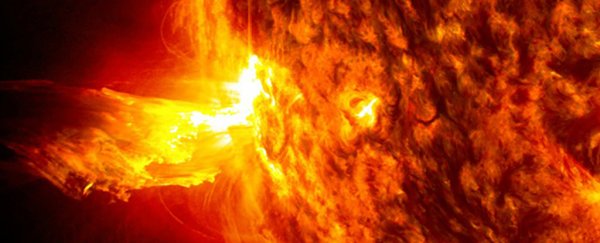Scientists just discovered evidence of a massive solar storm that happened some 2,679 years ago. Such blasts of plasma and electromagnetic radiation from the Sun have the potential to seriously impact life on Earth, so it's important for us to understand them as much as we can.
The evidence they dug up is in the form of radioactive particles previously hidden under the ice sheets of Greenland, and experts are saying the ancient event could be one of the biggest solar storms to have ever hit Earth.
If a similar-sized storm were to strike our planet today, the consequences would be disastrous – radio signals and satellite communications disrupted, power grids disabled, and a whole host of modern day systems damaged, from banking to transportation.
"If that solar storm had occurred today, it could have had severe effects on our high-tech society," says one of the researchers, geologist Raimund Muscheler from Lund University in Sweden. "That's why we must increase society's protection against solar storms."
Using ice cores extracted in Greenland - thought to contain ice formed over the past 100,000 years or so - Muscheler and his team were able to date a significant solar storm back to 660 BCE.
The tell-tale signs were elevated levels of beryllium-10 and chlorine-36 isotopes embedded in the ice, both evidence of chemical reactions kicked off by the Sun's activity reaching through Earth's magnetic shield to the surface.
In this case it was a solar proton event or SPE, a particularly intense type of solar storm where the released particles include high-energy protons.
We've seen SPEs in the past, affecting Canada in 1989 and Sweden in 2003. But this event nearly 2,700 years ago appears to have been more than 10 times stronger than any storm we've detected in the last 70 years.
"There are high-energy solar energetic particle events, or solar proton events," Muscheler told Paul Rincon at BBC News. "These are the high energy particles directly hitting Earth and producing the particles we measure.
"Connected to this are also the lower energy particles that come usually within one to four days to Earth. These produce the geomagnetic storms."
Researchers have also previously found similar events dated to 774-775 AD and 993-994 AD. The upshot is that these heavy storms are occurring more regularly than we thought they were, and can be more powerful than anything we've seen in the modern era, and that affects contingency planning.
In the year 660 BCE – the Iron Age in Europe and the Middle East – no one would have really noticed an extra blast of solar particles, unless they were particular keen scholars of aurora effects in the sky.
Today that extra radiation would be potentially dangerous for astronauts on the ISS and passengers flying on planes at high altitude, besides threatening a lot of the modern technology we've come to rely on.
As for which is the biggest ever, it's a close call between the 774-775 AD and the 660 BCE events, as they're both similar in terms of magnitude from the records scientists have been able to gather from ice cores and tree rings (where carbon-14 is the isotope to look out for).
Three major events isn't enough to form any future predictions, and as is often the case, more data is going to help us pin down the threat of solar storms more precisely. In the meantime, we'd be wise to develop systems and equipment that aren't going to come crashing down if the event of 660 BCE is repeated.
"Our research suggests that the risks are currently underestimated. We need to be better prepared," says Muscheler.
The research has been published in PNAS.
